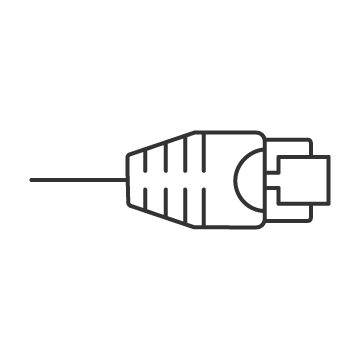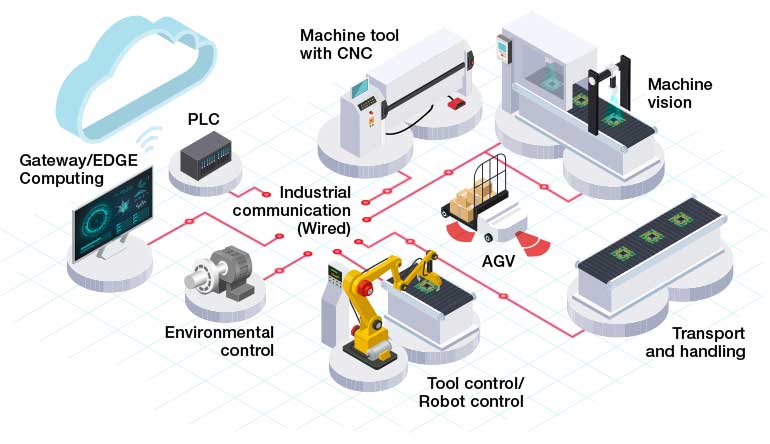SSZT382 november 2019 DP83825I , DP83826E , DP83826I , DP83848VYB , DP83848YB , DP83867CR , DP83867CS , DP83867E , DP83867IR , DP83867IS , DP83869HM , ESD321 , ESDS314
Since its advent, Ethernet has grown by leaps and bounds, deployed prolifically in the commercial and enterprise markets. Due to well-defined standards and ease of deployment, it was only logical for Ethernet to spread in the industrial world as well. Meeting Ethernet requirements in harsh industrial environments requires a lot of insight and effort, however.
| Low-latency 10/100-Mbps Ethernet PHY | |

|
Reduce system response time or add extra nodes in daisy-chained networks without increasing system size or cost with the DP83826E. |
The industrial environment, as shown in Figure 1, is very different from the commercial environment and poses its own set of challenges. Industrial environments often include harsh conditions like higher temperature ranges and voltages, higher noise, mechanical stress, etc. To meet the needs of this demanding environment, an industrial-grade Ethernet physical layer (PHY) must perform according to the requirements of Ethernet protocols. In this article, I’ll briefly describe the three most important aspects to consider when selecting Ethernet PHYs for your system.
 Figure 1 Modern industrial setting
connected by wireless and wired connections, including Ethernet.
Figure 1 Modern industrial setting
connected by wireless and wired connections, including Ethernet.1. Low latency. Latency is the time it takes for packets to travel from source to destination. Different sections in a network will contribute to the total network latency. Communication in an industrial network is time-critical, which means that delays should be minimal and deterministic. Higher delay and varying packet arrival times degrade system performance.
Standard Ethernet is non-deterministic. IEEE 802.3 standards do not specify a maximum latency number for Ethernet PHYs. However, having low and deterministic latency becomes very important for Ethernet transceivers in an industrial environment. Low and deterministic latency enables faster response time and increases predictability. Low latency allows applications to run faster as there is less waiting time for information to propagate through the network and deterministic latency improves the synchronization of different networks since the delay remains constant.
Learn more about low and deterministic latency and how it is critical for industrial communications designs in this video.
Low latency vs. low, deterministic latency Ethernet in real-time communications
2. EMI/EMC mitigation. Electromagnetic interference (EMI) is the unintentional electromagnetic energy produced by a system. Electromagnetic compatibility (EMC), on the other hand, is a system’s ability to operate in an environment where there is electromagnetic energy generated by other systems. EMI and EMC are important parameters in industrial environments that may have multiple sources of electromagnetic energy. A system with bad EMI performance would radiate large amounts of energy, which can disrupt nearby sensitive devices and reduce efficiency, since energy is wasted in radiation. A poor EMC design may cause a system to be highly sensitive to these disruptions, potentially leading to performance issues. The performance of systems with poor EMC design may also be affected by other typical sources of radiation like Wi-Fi, cellphones, etc.
There are different EMI/EMC standards such as European Normalization (EN), Comité International Spécial des Perturbations Radioélectriques (CISPR), Federal Communications Commission (FCC), etc., which vary depending upon the region of the world and the intended market. A device must meet the requirements defined by these standards before being certified for use. These standards change according to the final application of the device. The EMI/EMC criteria for the industrial market are much stricter than those for the commercial market.
3. ESD protection. Electrostatic discharge (ESD) is a sudden flow of electricity into a system that comes in contact with a charged object. ESD events are short, but they can inject huge amounts of energy into a system. If a device is not designed to sustain such events, the results can be catastrophic for the device, often leading to the device being destroyed. Since ESD doesn’t always leave behind visible signs of damage, it becomes very difficult to find the damaged device in a complex system. Being such an important parameter, ESD standards such as International Electrotechnical Commission (IEC) 61000-4-2 are in place to set a minimum requirement, which devices must meet depending on their final application. Similar to EMI/EMC, ESD requirements are stricter for the industrial market than for the commercial market.
An industrial-grade Ethernet PHY should have low deterministic latency, comply with strict EMI/EMC standards and resist ESD events. Our Ethernet portfolio is designed to meet these requirements and has been adopted into many harsh industrial environments around the world - and includes devices such as the DP83867 industrial Gigabit Ethernet PHY and the DP83826E 10/100 Ethernet PHY.
We also offer a portfolio of discrete ESD and surge protection diodes that can increase the overall robustness of the system even more. A device like ESD321 can withstand up to 30 kV of an IEC 61000-4-2 ESD strike while still having a low line capacitance to support high speed signals. For surge protection, a device like the ESDS314 can be used to withstand IEC 61000-4-5 surge pulse up to 25 A. To learn more about external ESD and surge protection, visit the ESD and surge training page
Additional resources
- Learn how to streamline PHY selection for your next design with part 1 of our "SimpliPHY your Ethernet design" technical article series.
- Jump-start your design with the TI Designs EMI/EMC-Compliant Industrial Temp Dual Port Gigabit Ethernet reference design.
- Experiment with TI’s new Gigabit Ethernet PHY with an EN5011-compliant evaluation module.
- Learn more about latency in the application report, “Latency in Factory Automation.”
- Find out about EMI/EMC design guidelines in the application report, “Reducing Radiated Emission.”